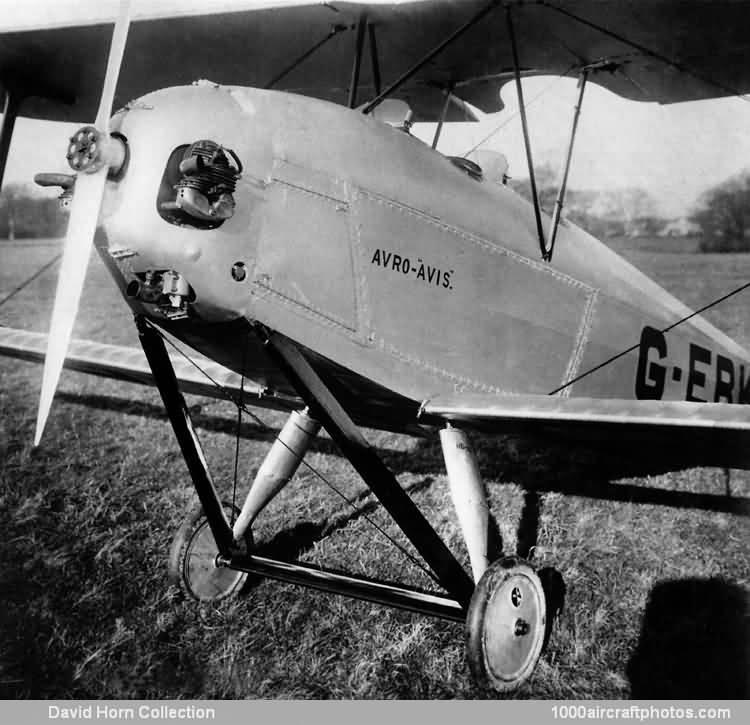03/31/2012. Remarks by Johan Visschedijk: "A.V. Roe and Co. Ltd. (trading as Avro) designed the Avis for entry in the Air Ministry's Two-seat Light Aeroplane Trials held at Lympne September 29 - October 4, 1924. It was a small equal span, single-bay biplane slightly reminiscent of the Avro 514 of 1914 with circular rudder and single I-type interplane struts. The fuselage was the usual wire-braced, fabric covered Warren girder with plywood top decking, and the wings were designed to fold to comply with the rules of the competition. A pair of steel V-shaped jury struts were provided to support the inner ends when folded.
Ailerons ran the full length of all four wings, the upper pair being linked to the lower by rods at the inner end so that all four could be depressed to act as flaps on final approach by means of an ingenious worm drive mechanism. A long travel oleo landing gear with front radius rods completed a very business-like little aeroplane. Although first flown at Hamble with a 35 hp Blackburne Thrush direct drive, three cylinder radial, an alternative mounting was built to enable a 32 hp Bristol Cherub II geared horizontally-opposed engine to be substituted when required.
Remembering the previous year's disappointment when competition regulations prevented the Avro 560 monoplane from flying at Lympne with the short span mainplane, the Avis biplane was entered as two separate aeroplanes, No. 10 with Cherub and No. 11 with Thrush. In the event this precaution was unnecessary as the Thrush was not used.
When the machine was delivered at Lympne by road on September 28, the Cherub had not yet been installed but this work was completed during the next two days. Unfortunately snags were encountered and the engine appeared to give only half power. After several attempts during the afternoon of September 30, Avro test pilot Bert Hinkler managed to get the Avis airborne, but not daring to venture round the course, was eliminated from the competitions.
This was most regrettable because on October 2 the Cherub performed to such effect that the Avis reached a height of 2,000 ft (610 m). Nevertheless a new direct drive 32.6 hp Cherub I of proven reliability was substituted and on October 1 Hinkler gave flights to Director of Civil Aviation Sir Sefton Brancker and Air Vice-Marshal Sir Geoffrey Salmond. Next day Avro enterprise was at last rewarded when, in a field of thirteen aircraft, Hinkler won the Grosvenor Challenge Trophy by flying the Avis eight times round the 12.5 mls (20.1 km) course at an average speed of 65.87 mph (106.0 kmh). With his wife as passenger, HinkIer then flew the Avis triumphantly back to Hamble with a night stop at Croydon on October 6 and a fuelling stop at Farnborough next day.
The Avis reappeared at the Lympne August Meeting on August 1, 1925 still with direct drive Cherub, which this time drove a duralumin airscrew specially made for it by Avro. Hinkler, very familiar with the 12.5 mls (20.1 km) circuit, came third in the International Light Aeroplane Holiday Handicap at 64.8 mph (104.3 kmh) and fifth in the Grosvenor Challenge Trophy Race at 65.32 mph (105.12 kmh). At this stage the Avis cowlings differed from those of the previous year because the cylinder heads of the direct drive Cherub were lower in relation to the thrust line of the airscrew than those of the geared engine. It also bore civil registration G-EBKP allocated to it in December 1924.
As 'second string' to Avro's new Avian prototype for the Two-seat Light Aeroplane Trials at Lympne, September 12-17, 1926, the Avis reverted to a Thrush engine, this time the new and slightly heavier 38 hp model. Painted yellow and flown by Wing Commander W. Sholto Douglas (later Lord Douglas of Kirtleside), the machine averaged 51.25 mph (82.48 kmh) to Shoreham and back on the first day but was eliminated when the landing gear was damaged in a forced landing on the second.
In 1927 Avro refined the direct drive Cherub and in 1928 disposed of the Avis to private owner E.L.O. Baddeley who kept it only a few months before advertising it for sale. On October 11 the machine was eventually registered to T. S. Baldwin, garage proprietor of Totnes, Devon, who finally scrapped it at the end of 1931, the registration being cancelled on December 7."
